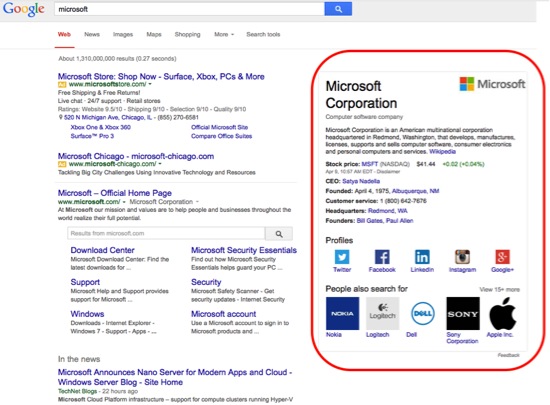Google’s Knowledge Graph and SEO: How to optimize your brand’s presence.
By Nicholas Papagiannis
Understanding Knowledge Graph
Google’s Knowledge Graph is a knowledge base consisting of more than 570 million objects and 18 billion facts. Since its inception in 2012, search result pages have gone through significant display changes since it allows Google to distinguish the user’s intent of a search phrase. Google search results are no longer just linking to web pages; they are providing facts and information about a topic or brand on the actual search result page. This provides searchers with a quicker answer to their search and a better user experience.

Knowledge Graph Sources
Wikipedia, Freebase, and the CIA World Factbook are 3rd party sources from which Knowledge Graph pulls information. Since it’s impossible to edit the CIA Factbook and Freebase is being retired on June 30, 2015, brands are left with Wikipedia as the main entry point for Knowledge Graph.
Data from Google+ is also pulled in. It’s important that brands verify information on Google+ and claim their page as business owners. A good example is the search result for GM. It pulls in a mix of Wikipedia data, as well as data shared on Google+. It’s important for brands to link their website with their Google+ brand page. This can be done via a direct link on the site or through Webmaster Tools.
Structured Snippets are one of the newest inputs and displays of the Knowledge Graph, they’re basically enhanced search result listings. One example of a Structured Snippet is a product review that may be pulled into the search results. Sites should work with their Web development and SEO teams to determine the right Snippets or Schema.org mark up for the content they offer on their site.


Implications for Brands
Implications for Brands
Since more and more searches are referencing Google’s Knowledge Graph it’s important that brands optimize their search result for brand searches. Here are some important to-dos for brands.
- Build a Wikipedia Page. Every notable brand should have a Wikipedia page. To do that, it will require third party content to cite information and a lot of patience since Wikipedia has a lot of rules when creating a page. Brands should run searches for popular brands in their category. If their brand results are strong, they should look at their Wikipedia presence and reference their format prior to creating their Wikipedia format.
- Link the Google Plus with the brand website. It’s important you align your website content with your Google Plus page. This could be done via Google Webmaster Tools or through direct linkage of the site. Visit the Google My Business forum for more details on how to do this.
- Optimize Snippets through Schema.org. Brands should work with their SEO and Web development team to implement Schema.org tags for content on their site. SEO teams should conduct an audit of all the possible Schema options and determine which tags are suitable for the content presented on the site.
More Insights
- December 15, 2014 Agency gift guide.
- August 12, 2014 Our 2014 interns are so good it’s criminal.*
